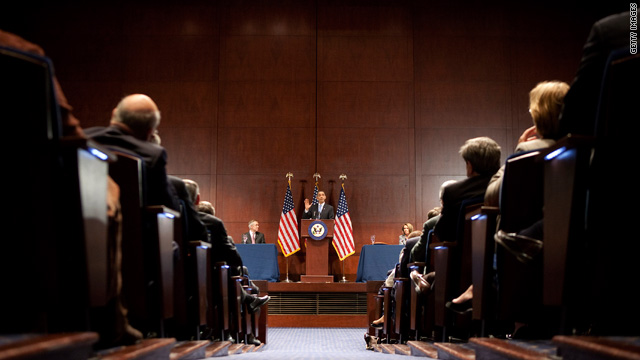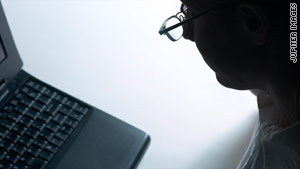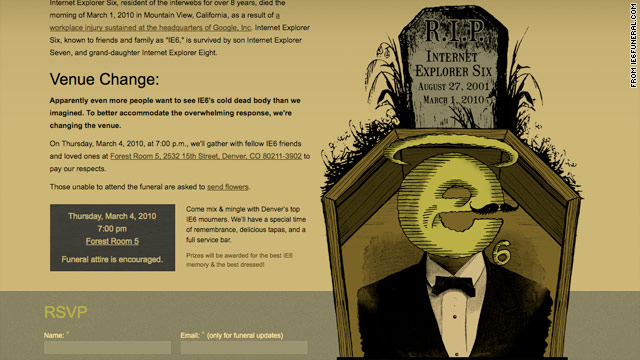
For decades, health care has sparked controversy in American politics. In the 14 months since President Obama took the oath of office, the issue has been debated passionately and exhaustively. With House passage of a sweeping health care bill, CNN.com asked a variety of political and medical experts to comment.
John P. Avlon, a senior political columnist for The Daily Beast and author of "Wingnuts: How the Lunatic Fringe is Hijacking America":
First, the big picture -- the passage of health care reform is a huge win for President Obama, a goal that has been unsuccessfully pursued by presidents since Teddy Roosevelt. But while Obama succeeded in gaining the endorsement of the American Medical Association, an influential opponent of previous health care reform efforts, this is unfortunately not a unifying win for the nation.
After a year of heated debate, the American people remain deeply divided on this legislation, and Democrats are looking at a tough re-election fight this fall. Most major pieces of social legislation in American history -- such as Social Security, Medicaid and welfare reform -- have passed with broad bipartisan support. The Democrats' political bet is that rallying the base with a win on liberals' longtime No. 1 issue will outweigh anger from conservatives and distrust of one-party rule from independent voters.
The reality is that even though the vote is over, the fight over health care reform is not. Opponents, including the attorney generals of several states, are expected to file lawsuits asking the courts to declare the bill unconstitutional. The anger of conservative activists has been stirred to fever pitch -- witness the spitting at Rep. Emmanuel Cleaver or slurs directed at Reps. John Lewis and Barney Frank during Capitol Hill protests Saturday -- and it will not go away any time soon. At a time when some people feel like losing an election is living under tyranny, the passage of this health care reform bill has taken on significance far beyond the legislation itself.
Most Americans agree there are problems with the current health care system, but despite this diagnosis we cannot agree on a cure. Sunday's party-line vote is the latest sign of a divided Washington where concepts like common ground and the common good don't seem to drive political debates. This historic win will be followed by even more discord in D.C.
Kevin Pho, a primary care physician in Nashua, New Hampshire, who blogs at KevinMD.com:
With health reform passing the House, a comprehensive overhaul of our health care system draws another step closer.
Coverage will expand to cover nearly 95 percent of legal U.S. residents. With a recent study showing that patients without health insurance have a shorter life span, coupled with the number of uninsured approaching 50 million in 2010, that is perhaps the biggest reason to cheer.
But with a critical shortage of primary care providers, these newly insured patients may have nowhere to turn for medical care. Massachusetts, the only state that offers universal coverage, suffers from some of the worst primary care wait times in the country despite having the highest concentration of doctors nationwide.
Health reform tries to help, mostly by modestly increasing both Medicaid and Medicare payments to primary care clinicians. But it's not nearly enough to convince medical students, already grappling with crippling school debt, who continue to gravitate toward lucrative specialty practice.
And what about the current primary care work force, where, according to a study in the Annals of Internal Medicine, more than a quarter of doctors reported being burnt out and 30 percent indicated they would leave the field within five years? Health reform gives few solutions to alleviate the bureaucratic obstacles and time pressures that frustrate doctors and impede their relationship with patients.
Finally, the mere $50 million allotted to medical malpractice reform doesn't help patients hurt by medical mistakes, who are trapped in a dysfunctional system where one in six receives no financial compensation, the average case takes five years to resolve, and 54 cents of every awarded dollar go to pay legal fees. These individuals deserve an improved liability system that more fairly expedites compensation and helps doctors reduce errors and improve patient safety.
Although it's worth celebrating that the United States is close to joining the rest of the industrialized world in providing near-universal health coverage, the health reform conversation must continue -- both to improve the plight of injured patients and to ensure that the millions of newly insured have access to quality primary care.
Ed Rollins, CNN senior political contributor, senior presidential fellow at the Kalikow Center for the Study of the American Presidency at Hofstra University and White House political director for President Reagan:
The Democrats did it. President Obama and Speaker [Nancy] Pelosi battered and cajoled a majority of Democrat House members to pass one of the most far-reaching and expensive entitlement programs in our history. The speaker said Sunday, "We're doing this for the American people."
It would be far more correct if she said we're doing what we think is best for the American people. According to polls, most Americans don't want this plan. But what we want certainly doesn't matter to Pelosi and those "smart Congress people" in Washington who think they know more than we do.
And telling the whole truth would be a new exercise in selling this program. Never has so much misinformation been spun to the public. We don't have to read the 2,000-page bill to find out the truth.
These are the facts, and they are not debatable. For those who have health insurance, you are in all probability going to pay more and get less. The American public is getting a tax increase -- and not just the rich ($200,000 is defined as rich). The so-called "Cadillac" health insurance plans will be taxed, and there are a variety of other taxes on businesses that will undoubtedly be passed on to consumers.
Doctors and hospitals are going to be paid less for services. Forty-six cents out of every dollar spent on medicine is paid for by you the taxpayers. Just know you're going to pay more.
Small and large businesses are going to have to pay more for their employees' health insurance plans. And every American is mandated to have health insurance whether we want it or not.
The elderly on Medicare will see their benefits changed dramatically. The biggest item being used to pay for the new program is more than $500 billion in cuts to the Medicare program at a time when 72 million baby boomers become eligible for it in the next decade. The second biggest move to pay for this is by raising and expanding the Medicare tax.
It is true some Americans will benefit. By 2014, according to the Congressional Budget Office, this bill will give 19 million uninsured Americans subsidies averaging $6,000 to help pay premiums and other medical charges. This is in addition to the federal government already picking up the tab for nearly 100 million Americans through Medicare (the elderly) and Medicaid (the poor, disabled and many children).
The smart people in D.C., including the president and the speaker will be long gone (as well as a bunch of Democrats who will lose in November) when the debts come due. But our children and grandchildren will be left with the tab.
Donna Brazile, a CNN contributor, Democratic strategist, vice chair for voter registration and participation at the Democratic National Committee, nationally syndicated columnist and an adjunct professor at Georgetown University:
Sunday night, the House passed a historic bill to reform our nation's health care system. This is a bill with ideas from both major political parties that will provide access to quality, affordable health care and reduce the federal budget deficit.
The nonpartisan Congressional Budget Office has projected that the bill will reduce the deficit by $138 billion in the first decade and will reduce the deficit by as much as $1.3 trillion in the second decade. In addition, the CBO confirms the bill both reins in wasteful spending to extend the solvency of Medicare for almost 10 years and closes the prescription drug "doughnut" hole for seniors.
If my mother were here today, Mom Jean would be proud. She died at 52. She worked every day but couldn't afford health insurance. Her employer did not offer it. When she became ill, she waited until she couldn't wait any longer, then went to the emergency room. Three days later, she was dead.
Growing up, my mom would tell her nine kids that we could not afford to get sick. She was right. We didn't have money for medicine or doctors' visits, so the only choice was to stay well. It's the same "choice" millions of families face: Stay well or else.
But not anymore. It's a day Mom Jean would love to have seen.
Thanks to Nancy Pelosi and a majority of Congress, millions of moms and dads will have access to quality, affordable health care for themselves and their children. An estimated 32 million people will be able to rest comfortably knowing that they are no longer a flu away from foreclosure because they lack health insurance. All of us can sleep a little better knowing that pre-existing conditions no longer preclude affordable health insurance. These are major victories.
This was a tough vote and an emotional debate. We can't let our exhaustion limit our celebration. We haven't had a major health care reform in nearly 50 years. What Congress accomplished this week is worth celebrating.
Jennifer Klein, a professor at Yale University who specializes in American history and author of "For All These Rights: Business, Labor, and the Shaping of America's Public-Private Welfare State":
Since the end of the Civil War, the great strides in deepening and expanding American citizenship have come from federal government action. Like the 14th Amendment establishing a principle of equal protection of the law, the 15th and 19th amendments extending the right to vote, the Social Security Act and federal minimum wage, the 1964 Civil Rights Act and 1965 Voting Rights Act, the newly enacted Health Reform Act adds to the rights of American citizenship.
The new bill will not displace private health insurers, hospitals, doctors or other institutions; it will not overhaul a market-based mode of providing actual medical services. Its passage, however, is a pivotal political moment like those landmarks that came before, because the federal government has now taken on the responsibility of establishing a national standard for economic security -- regardless of where you work or what state you live in. Insurers will have to play by national rules.
We can also place this particular reform moment in the tradition of American populism -- that is, the populism that built the People's Party in the 1890s. Mainstream media and pundits have been relentlessly characterizing opposition to health care reform as populism, springing from some deep well of American authenticity. But if we actually take seriously both the discontents and demands of the Populist Party, here's what we'd find: a populism of economic grievances that offered a direct critique of concentrated economic power.
They condemned the monopoly control by railroad companies and oil companies that restricted workers' and farmers' access to and action within the marketplace and corrupted politics. And so they turned to the federal government to counter that power.
Populists and the farmer-labor alliance of the 1890s aimed to create a regulatory state to realize economic security. In the party's Omaha platform of 1892, they put it clearly, "We believe that the power of government -- in other words, of the people -- should be expanded ... as rapidly and as far as the good sense of an intelligent people and the teachings of experience shall justify, to the end that oppression, injustice, and poverty shall eventually cease in the land."
The health care bill is a regulatory bill in this vein; it is not a social insurance bill like Social Security pensions or Medicare. It restrains the previously unchecked prerogative of the insurance corporations (like the railroad companies a century ago) to rig the market in their favor.
Both employers and insurance companies fought the passage of Social Security, lobbied for special exemptions and floated doomsday scenarios. Yet once it passed, business corporations quickly adapted. Indeed, the insurance companies decided Social Security was a tremendous boon to the sale of private insurance.
All of the pivotal liberal reforms have had their imperfections, concessions and constraints. It often took years of struggle to realize their full promise on the ground in daily life. So here we go.
Regina E. Herzlinger, the Nancy R. McPherson professor of business administration at Harvard Business School and author of "Who Killed Health Care?" and a director of a managed care public insurance firm:
The health care legislation laudably expands coverage but its costs, more than $900 billion, will put another nail in the coffin of the U.S. economy and open the door to a U.S. government-controlled health care system that gravely injures the sick along the way.
The problem is the absence of control of costs that already cripple U.S. global competitiveness. As a percentage of gross domestic product, the U.S. spends roughly 70 percent more on health care than other universal coverage nations, yet we cannot point to commensurate superiority in value.
The bill's cost controls rely primarily on public health insurance marketplaces, labeled exchanges, where private health insurers compete with public insurance. These initiatives don't control costs as much as shift them, to other payers, taxpayers and succeeding generations, through deficits, cutbacks and unfunded liabilities. Ultimately, absent entrepreneurial innovators and competition, they will lead to a single-payer health care system that controls costs by rationing care.
To picture their impact, imagine a government-run automobile dealership that sells cars made by Ford, Kia and other private firms, along with government-manufactured vehicles. Legislators offer voters generous subsidies, but only if they buy cars in the government-market. All the cars are virtually identical, designed by the legislature with dubious high-cost features. Legislators might, for example, cater to lobbyists from companies that make heated seats by requiring them in every car. (Remember that the health care legislation was strongly supported by the hospitals and the American Medical Association, which will surely want something in return.)
Nevertheless, the price of the high-cost government manufactured cars could be artificially reduced by passing some of their costs to future generations through unfunded deficits. Private competitors that cannot resort to deficit financing will thus be driven out of business. Ultimately, high-cost cars and absence of entrepreneurs and competition will skyrocket costs and force government to ration cars.
Although government rationing can squeeze out some inefficiency, it is hardly benign or equitable: The single-payer UK national health system, for example, has the lowest adoption of cancer drugs among the biggest five European economies and correspondingly low cancer survival rates. Many of the UK's affluent buy private insurance to avoid government stringency, such as those in other European government-controlled systems.
Of course, we must reform health care. But the present bill will inevitably increase costs, further weakening our economy. Tragically, although it will expand insurance coverage, it will ultimately result in rationed medical care for its beneficiaries.
Matt Welch, editor in chief of Reason:
The sky won't fall. It almost never does. Some might argue that's part of the problem.
Those on my exceedingly narrow ledge of this debate -- against both "Obamacare" and George W. Bush's huge 2003 Medicare expansion, in favor of individual choice in all human endeavors, and genuinely alarmed at the lousy long-term consequences of Bush/Obama bailout economics -- are indulging in a bit of "RIP USA" rhetoric after this monumentally expensive lurch still further in the direction of Washington centrism.
But the perhaps less satisfying reality is that we will continue muddling along, doubling the wager while decreasing the odds that private sector innovation will keep on producing enough surplus cash to pay for public sector mistakes.
Our new health care system will certainly be much more expensive than shamelessly advertised. Some people happy with their current health plan will wake up one day to see that it no longer exists. But there will be no telegenic apocalypse, no collapse of the public finances. Instead, there will be a daily drip of deterioration, sporadically rupturing into crises and even bankruptcies on the state and local level, followed by more federal bailouts and a steady establishmentarian drumbeat of hiking taxes to cover "structural" budget deficits.
Will citizens keep tolerating a political class that devours ever-greater resources while producing ever-crappier results? As long as government has a guaranteed revenue stream and a captive consumer base, split between two unprincipled parties who collude against would-be competitors, they may not have a choice.
Dr. Manoj Jain, a Memphis, Tennessee-based infectious disease physician, adjunct assistant professor at Rollins School of Public Health at Emory University and medical director at Tennessee's Quality Improvement Organizations:
Last week, I saw a 55-year-old truck driver who pleaded with me to discharge him from the hospital even though his face and scalp still bore clear signs of an active staph infection. For a decade he has had recurrent staph infections exacerbated by diabetes -- yet could not afford insulin or a doctor because he lacked medical insurance. Now he begs me to let him leave, so that he will not go bankrupt from his medical bills.
I turn to his wife who says, "I am lucky. I have metastatic breast cancer, and I am covered by Medicare."
One of every 10 patients I see do not have health insurance.
I see the uninsured patients, but then make up for my losses by increasing my charges to all my patients. The cycle continues: Insurers increase premiums, choking small businesses that then drop health coverage for their employees, leading more uninsured to come to my practice.
Not providing insurance is not free; the annual health care expenditure for an uninsured adult is $1,800, according to a Kaiser Foundation study in 2004.
And there is a downside to having nearly 50 million uninsured people in America. I look them in the eye, and I know this for a fact. They will die sooner. In my opinion, lack of health insurance is a chronic illness.
The burden of this disease is most apparent among people between the ages of 54 to 65. A 2004 Health Affairs study found that lack of insurance accounts for 13,000 lives lost per year, making lack of insurance the third leading cause of death for this group, after heart disease and cancer. If we do nothing to address this problem, by 2015 lack of insurance will account for 30,000 deaths annually in just this age group.
In all fairness the present health system provides some care for the uninsured. President Bush was technically accurate when he said in July 2007, "People have access to health care in America. After all, you just go to an emergency room."
But the distinction between an acute illness -- the kind that sends you to the emergency room -- and chronic disease is artificial. For example, each year, diabetes, a chronic disease, causes 20,000 Americans to go blind, 45,000 Americans to have kidney failure and 45,000 Americans to lose a limb. Lack of health insurance is the same -- a chronic illness causing recurrent acute illnesses.
I want to lean over and shake my uninsured patients and scream, "Be a Rosa Parks. Demand health care as a right -- just as others before you have marched for civil rights and human rights."
The uninsured have become second-class citizens. Nearly 30 million of them, who are the working poor, are unable to afford health insurance, and there is no one to unite them and voice their concerns.
The Rev. Martin Luther King Jr. was not silent about people's right to health care. "Of all the forms of inequality," he said, "injustice in health care is the most shocking and inhumane." He was speaking, I believe, of both acute care and chronic care.
Vance Harris, a primary care physician in Redding, California:
The votes have been counted but, in reality, there is no clear winner.
What is clear -- our health care system is terminally ill. Bold leadership is needed to redirect precious resources. Unfortunately bold leadership is just as scarce as precious resources.
There will be no new access to health care if we do not have physicians to provide it. We must reverse the trend that sees thousands of physicians leaving primary care. Bold leadership is needed to get the brightest minds back into one of the most challenging and demanding roles. We need motivated empowered physicians with a passion for health and the ability to care for a whole landscape of disease. We must treat decisively when possible, not just shuffle everyone down the road to a specialist.
Give us five more minutes with patients to deal with a second or even a third problem so they don't access the system twice. Give us five minutes of straight talk about the impact of lifestyle on their health. Without this, I default back to putting out fires and I write another prescription.
We need "Health" Reform not just Sickness Access Reform. We are not a healthy nation. Our indulgent lifestyle of overeating and under exercising is rapidly filling the beds needed for treating disease we can't prevent. This is exactly why we have a "Sickness Care" system. However, having the resources to treat sickness is dependent on true health care.
Our battle cry must be health, not health care reform. Seek out physicians who understand the value of health. Unfortunately, we do not have many of those doctors left. Who is going to take care of us when they are all gone?








.jpg)







